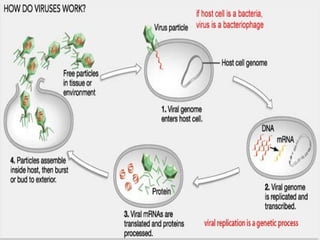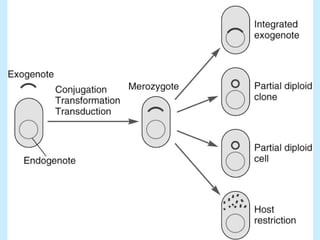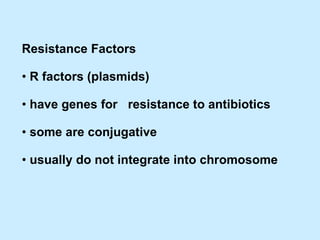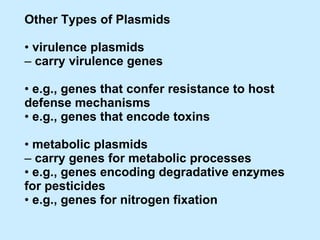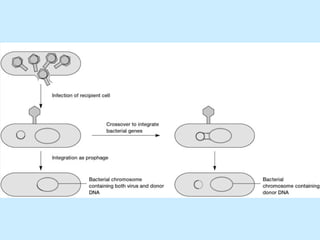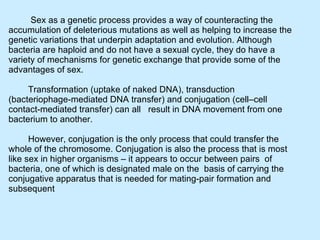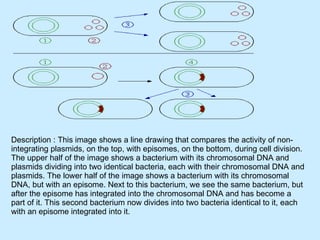genetic variations
- 1. GENETIC VARAITIONS, PLASMIDS, RECOMBINATIONS, TRANSFORMATION etc WITH EXAMPLES. Dr.N.R.P.REDDY
- 3. Bacteria multiply exponentially. The generation time varies: 20 min. in perfect conditions; hours in a real infection. Growing exponentially means one cell can turn into millions of bacteria. Daughters are identical to the parent, this is a clonal population, all are genetically identical. A clone is represented on an agar plate by a single bacterial colony. But DNA changes. This affects the properties of the bacteria and creates a subclone within the population. Mutations occur at a low frequency, 1 in a million cells will have a mutation in any gene. Because bacteria grow so rapidly, this is actually a significant number. Vertical Inheritance of mutations
- 4. Mutation Outcomes : 1) Deleterious: blocking or disrupting a gene causes a disadvantage (lethal, slow growth). This population dies out by being taken over by wild type (normal) bacteria. 2) Beneficial: mutation has added an advantageous function to the cell, like antibiotic resistance. Under the appropriate conditions, this advantageous mutation will be selected for and will overtake the other populations of bacteria. 3) Random/Spontaneous: no obvious effect on phenotype, silent mutations. These can accumulate and the sum can then lead to change in gene function Two kinds of physical mutations (occur at the same low spontaneous rate) Point mutations: change of a single nucleotide 2) DNA rearrangements: shuffling of the genetic information to produce insertions, deletions, inversions, or changes in structure (several thousand nucleotides)
- 5. DNA can be transferred from one bacteria to another and assuming stable inheritance, this acquisition of genetic material will form a new subclone population. 1) transformation – results from the release and uptake of naked DNA (from lysed cells for instance). New DNA is incorporated into the chromosome. This is the most inefficient form of transfer since the DNA is open to the damaging environment, and requires a high density of bacteria. 2) transduction – bacterial genes are transferred in virus particles. Bacteriophages package DNA and inject DNA into other bacteria. This is much more efficient because of a good apparatus which also protects the DNA in a safe protein coat. However, the amount of DNA is limited by the capsid size. Furthermore, phage can only infect bacteria expressing the correct receptor, so there is a tropism to the transfer of DNA. 3) conjugation – this involves cell to cell contact. Two cells come into contact, a pore is formed and DNA is transferred from one to the other. Very efficient and rapid and is able to transfer large amounts of DNA This is the most prevalent form of DNA transfer. CONJUGATION IS PROMISCUOUS. Horizontal inheritance .
- 6. Transmission of genetic variation
- 8. DNA Transformation • uptake of naked DNA molecule from the environment and incorporation into recipient in a heritable form • competent cell – capable of taking up DNA • may be important route of genetic exchange in nature
- 11. Transmission of genetic variation: conjugation Direct transfer of DNA from one strain to another mediated by fertility factor (F). • Best studied in E. coli , and approximately a third of freshly isolated E. coli have plasmids. • Conjugative plasmids have been found in approximately 30 genera of bacteria, mostly gram-negative. Antibiotic resistance plasmids RP4 & R68.45 can propagate and promote conjugation in virtually any gram-negative bacterium. • Some gram-positive conjugate such as Streptococci, Staphylococcus, Streptomyces, Clostridium, and Bacillus .
- 12. Bacterial Conjugation • transfer of DNA by direct cell to cell contact • discovered 1946 by Lederberg and Tatum
- 17. Figure 9. Increase of bacteria resistant to 3 antibiotics over time and cartoon of Superbacteria with many resistance plasmids.
- 18. Transduction • transfer of bacterial genes by viruses • virulent bacteriophages – reproduce using lytic life cycle • temperate bacteriophages – reproduce using lysogenic life cycle
- 19. Generalized Transduction • any part of bacterial genome can be transferred • occurs during lytic cycle • during viral assembly, fragments of host DNA mistakenly packaged into phage head – generalized transducing particle
- 24. Horizontal gene transfer • transfer of genes from one mature, independent organism (donor) to another (recipient) • exogenote – DNA that is transferred to recipient • endogenote – genome of recipient • merozyogote – recipient cell that is temporarily diploid as result of transfer process
- 26. Bacterial Plasmids • small, double-stranded, usually circular DNA molecules • are replicons – have their own origin of replication – can exist as single copies or as multiple copies • curing – elimination of plasmid – can be spontaneous or induced by treatments that inhibit plasmid replication but not host cell reproduction
- 27. Bacterial plasmids… • episomes – plasmids that can exist either with or without integrating into chromosome • conjugative plasmids – have genes for pili – can transfer copies of themselves to other bacteria during conjugation
- 29. Resistance Factors • R factors (plasmids) • have genes for resistance to antibiotics • some are conjugative • usually do not integrate into chromosome
- 30. Col plasmids • encode colicin – kills E. coli – a type of bacteriocin • protein that destroys other bacteria, usually closely related species • some are conjugative • some carry resistance genes
- 31. Other Types of Plasmids • virulence plasmids – carry virulence genes • e.g., genes that confer resistance to host defense mechanisms • e.g., genes that encode toxins • metabolic plasmids – carry genes for metabolic processes • e.g., genes encoding degradative enzymes for pesticides • e.g., genes for nitrogen fixation
- 32. Generalized transduction abortive transductants- bacteria with nonintegrated transduced DNA
- 34. Sex as a genetic process provides a way of counteracting the accumulation of deleterious mutations as well as helping to increase the genetic variations that underpin adaptation and evolution. Although bacteria are haploid and do not have a sexual cycle, they do have a variety of mechanisms for genetic exchange that provide some of the advantages of sex. Transformation (uptake of naked DNA), transduction (bacteriophage-mediated DNA transfer) and conjugation (cell–cell contact-mediated transfer) can all result in DNA movement from one bacterium to another. However, conjugation is the only process that could transfer the whole of the chromosome. Conjugation is also the process that is most like sex in higher organisms – it appears to occur between pairs of bacteria, one of which is designated male on the basis of carrying the conjugative apparatus that is needed for mating-pair formation and subsequent
- 36. Description : This image shows a line drawing that compares the activity of non-integrating plasmids, on the top, with episomes, on the bottom, during cell division. The upper half of the image shows a bacterium with its chromosomal DNA and plasmids dividing into two identical bacteria, each with their chromosomal DNA and plasmids. The lower half of the image shows a bacterium with its chromosomal DNA, but with an episome. Next to this bacterium, we see the same bacterium, but after the episome has integrated into the chromosomal DNA and has become a part of it. This second bacterium now divides into two bacteria identical to it, each with an episome integrated into it.
- 37. Genetic variation: Implications for pathogenesis and antibiotic resistance I. Transduction a. Vibrio cholera b. Corynebacterium diphtheriae c. Neisseria meningitidis II. Transformation a. Neisseria gonorrhoeae b. Neisseria gonorrhoeae β-lactamase resistance c. Neisseria gonorrhoeae pilin variation III. Conjugation a. Bacillus spp. b. Enterococcus faecium






















